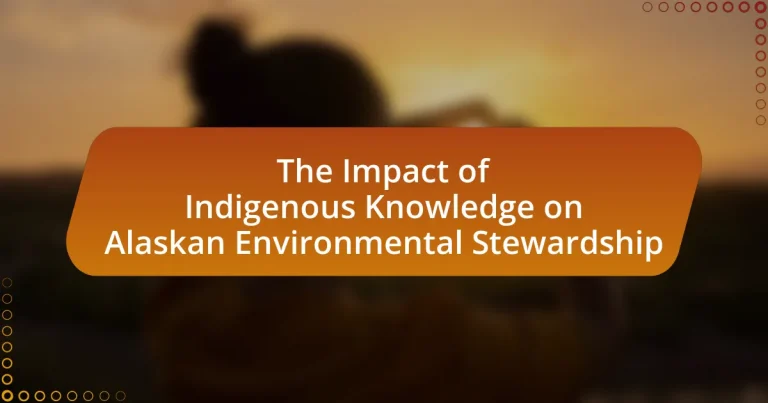The article examines the significant impact of Indigenous Knowledge on environmental stewardship in Alaska, highlighting how traditional ecological practices enhance contemporary conservation efforts. It discusses the integration of Indigenous practices, such as sustainable resource management and seasonal harvesting, with modern scientific approaches to address climate change and biodiversity conservation. Key principles of Indigenous Knowledge, methods of intergenerational transmission, and the challenges faced in modern stewardship are also explored. Additionally, the article emphasizes the importance of collaborative efforts between Indigenous communities and environmental organizations, showcasing successful case studies and methodologies that incorporate Indigenous perspectives into environmental research and policy-making.

What is the Impact of Indigenous Knowledge on Alaskan Environmental Stewardship?
Indigenous knowledge significantly enhances Alaskan environmental stewardship by integrating traditional ecological practices with contemporary conservation efforts. This knowledge, passed down through generations, includes sustainable resource management techniques that have been effective for thousands of years, such as seasonal hunting and fishing practices that align with ecological cycles. Research indicates that Indigenous communities in Alaska, such as the Iñupiat and Yupik, utilize their understanding of local ecosystems to inform climate adaptation strategies, which are crucial as climate change impacts their environment. For instance, the Alaska Native Science Commission emphasizes the importance of Indigenous observations in monitoring wildlife populations and habitat changes, demonstrating that this knowledge is vital for effective environmental management and policy-making.
How does Indigenous Knowledge influence environmental practices in Alaska?
Indigenous Knowledge significantly influences environmental practices in Alaska by integrating traditional ecological wisdom with contemporary conservation efforts. This knowledge encompasses a deep understanding of local ecosystems, seasonal changes, and sustainable resource management, which has been passed down through generations. For instance, Indigenous communities utilize traditional hunting, fishing, and gathering practices that align with the natural cycles of wildlife and plant growth, ensuring the sustainability of these resources. Research conducted by the Alaska Native Science Commission highlights that Indigenous practices, such as controlled burns and selective harvesting, enhance biodiversity and ecosystem resilience. This synergy between Indigenous Knowledge and environmental stewardship fosters a holistic approach to managing Alaska’s unique landscapes and resources.
What are the key principles of Indigenous Knowledge related to the environment?
The key principles of Indigenous Knowledge related to the environment include a deep understanding of local ecosystems, sustainable resource management, and the interconnectedness of all living beings. Indigenous communities possess extensive knowledge about biodiversity, seasonal changes, and ecological relationships, which has been developed over generations through direct interaction with their environment. This knowledge emphasizes the importance of stewardship, where the land is viewed as a living entity that requires respect and care. For instance, traditional practices such as controlled burning and selective harvesting are employed to maintain ecological balance and promote biodiversity. These principles are validated by studies showing that Indigenous land management practices can enhance ecosystem resilience and contribute to climate change mitigation.
How is Indigenous Knowledge passed down through generations?
Indigenous Knowledge is passed down through generations primarily through oral traditions, storytelling, and practical engagement with the environment. These methods ensure that cultural practices, ecological understanding, and historical experiences are shared within communities. For example, in Alaskan Indigenous cultures, elders often teach younger generations about local ecosystems, sustainable practices, and traditional resource management through hands-on activities and narratives that emphasize the importance of stewardship. This intergenerational transmission is crucial for maintaining cultural identity and ecological knowledge, as evidenced by the continued reliance on traditional ecological knowledge in contemporary environmental management practices in Alaska.
Why is Indigenous Knowledge important for environmental stewardship in Alaska?
Indigenous Knowledge is crucial for environmental stewardship in Alaska because it encompasses centuries of ecological understanding and sustainable practices that are deeply rooted in the region’s unique ecosystems. This knowledge includes traditional practices such as seasonal hunting, fishing, and gathering, which are informed by observations of environmental changes and species behavior. For instance, Indigenous communities have documented shifts in animal migration patterns and plant growth cycles, providing valuable insights for contemporary conservation efforts. Research indicates that integrating Indigenous Knowledge with scientific approaches leads to more effective management strategies, as seen in the collaborative efforts of the Alaska Native Science Commission, which emphasizes the importance of local expertise in addressing climate change impacts.
What unique insights does Indigenous Knowledge provide about local ecosystems?
Indigenous Knowledge offers unique insights into local ecosystems by emphasizing the interconnectedness of species, seasonal changes, and sustainable resource management practices. This knowledge, developed over generations, includes detailed observations of animal behavior, plant growth cycles, and weather patterns, which are crucial for understanding ecological balance. For instance, Indigenous communities in Alaska have documented the migration patterns of caribou and the spawning cycles of salmon, providing critical information for conservation efforts. Such insights contribute to biodiversity preservation and inform modern ecological practices, demonstrating the value of traditional ecological knowledge in contemporary environmental stewardship.
How does Indigenous Knowledge contribute to biodiversity conservation?
Indigenous Knowledge contributes to biodiversity conservation by integrating traditional ecological practices with contemporary conservation strategies. This knowledge encompasses a deep understanding of local ecosystems, species interactions, and sustainable resource management, which has been developed over generations. For instance, Indigenous communities in Alaska utilize traditional hunting, fishing, and gathering practices that promote species diversity and ecosystem health, as evidenced by their seasonal harvesting methods that align with natural cycles. Studies have shown that areas managed by Indigenous peoples often exhibit higher biodiversity levels compared to those under conventional management, highlighting the effectiveness of their practices in maintaining ecological balance.
What challenges does Indigenous Knowledge face in modern environmental stewardship?
Indigenous Knowledge faces significant challenges in modern environmental stewardship, primarily due to the marginalization of Indigenous voices and the dominance of Western scientific paradigms. This marginalization often leads to a lack of recognition and integration of Indigenous practices and perspectives in environmental policies and decision-making processes. For instance, a study by the United Nations Permanent Forum on Indigenous Issues highlights that Indigenous communities frequently encounter barriers in accessing platforms where their knowledge can influence environmental governance. Additionally, climate change poses a direct threat to traditional ecological knowledge, as shifting environmental conditions can disrupt the practices that have been passed down through generations. These challenges underscore the need for inclusive approaches that value and incorporate Indigenous Knowledge in contemporary environmental stewardship efforts.
How do climate change and industrialization impact Indigenous practices?
Climate change and industrialization significantly disrupt Indigenous practices by altering ecosystems and traditional ways of life. For instance, rising temperatures and changing precipitation patterns affect wildlife migration and plant growth, which are crucial for subsistence hunting and gathering. A study by the Arctic Council highlights that Indigenous communities in Alaska face challenges such as reduced access to traditional food sources due to melting ice and shifting animal populations. Additionally, industrial activities, such as oil extraction and mining, lead to habitat destruction and pollution, further threatening the sustainability of Indigenous practices. These changes undermine the cultural and spiritual connections that Indigenous peoples have with their land, as their traditional ecological knowledge becomes less applicable in a rapidly changing environment.
What role does policy play in recognizing Indigenous Knowledge?
Policy plays a crucial role in recognizing Indigenous Knowledge by providing a framework for its integration into environmental management and decision-making processes. This recognition is essential for ensuring that Indigenous perspectives and practices are respected and utilized in stewardship efforts, particularly in Alaska, where Indigenous communities possess extensive ecological knowledge developed over generations. For instance, the Alaska Native Claims Settlement Act of 1971 established a legal basis for the incorporation of Indigenous land management practices, thereby affirming the importance of Indigenous Knowledge in contemporary environmental policies. Such policies not only validate Indigenous perspectives but also enhance the effectiveness of environmental stewardship by combining traditional ecological knowledge with scientific approaches.

How is Indigenous Knowledge integrated into contemporary environmental management in Alaska?
Indigenous Knowledge is integrated into contemporary environmental management in Alaska through collaborative practices that incorporate traditional ecological knowledge (TEK) alongside scientific methods. This integration is evident in various initiatives, such as co-management agreements between Indigenous communities and governmental agencies, which aim to address issues like wildlife conservation and climate change adaptation. For instance, the Alaska Native Claims Settlement Act of 1971 established a framework for Indigenous land management, allowing local knowledge to inform resource management decisions. Additionally, research shows that TEK contributes valuable insights into local ecosystems, enhancing biodiversity conservation efforts and improving resilience against environmental changes.
What collaborative efforts exist between Indigenous communities and environmental organizations?
Collaborative efforts between Indigenous communities and environmental organizations include joint initiatives focused on land management, conservation projects, and climate change adaptation strategies. For instance, the Alaska Native Tribal Health Consortium collaborates with environmental organizations to address health impacts related to environmental changes, utilizing Indigenous knowledge to inform practices. Additionally, partnerships like the one between the Native American Rights Fund and various environmental groups work to protect Indigenous land rights while promoting sustainable environmental practices. These collaborations are often grounded in the recognition that Indigenous knowledge systems provide valuable insights into ecological stewardship, as evidenced by successful co-management agreements in areas like fisheries and wildlife conservation.
How do these collaborations enhance environmental outcomes?
Collaborations that integrate Indigenous knowledge with scientific approaches enhance environmental outcomes by fostering holistic management practices that are culturally relevant and ecologically sustainable. For instance, Indigenous communities possess a deep understanding of local ecosystems, which can lead to more effective conservation strategies, as evidenced by the successful restoration of salmon habitats in Alaska through traditional ecological knowledge. This synergy not only improves biodiversity but also strengthens community resilience against climate change impacts, demonstrating that such partnerships yield tangible benefits for both the environment and local populations.
What are some successful case studies of integration?
Successful case studies of integration in the context of Indigenous knowledge and Alaskan environmental stewardship include the collaboration between the Native Village of Eyak and the U.S. Forest Service, which focused on sustainable salmon habitat restoration. This partnership utilized traditional ecological knowledge to enhance fish populations and improve ecosystem health. Another example is the Kachemak Bay Research Reserve, where Indigenous practices were integrated into marine resource management, leading to improved biodiversity and community engagement. These cases demonstrate the effectiveness of combining Indigenous knowledge with scientific approaches to achieve environmental sustainability in Alaska.
What methodologies are used to incorporate Indigenous Knowledge into environmental research?
Methodologies used to incorporate Indigenous Knowledge into environmental research include participatory action research, community-based monitoring, and collaborative mapping. Participatory action research actively involves Indigenous communities in the research process, ensuring their knowledge and perspectives shape the study’s direction and outcomes. Community-based monitoring allows Indigenous peoples to collect and analyze data relevant to their environment, fostering a sense of ownership and responsibility. Collaborative mapping integrates traditional ecological knowledge with scientific data, enabling a comprehensive understanding of land use and resource management. These methodologies have been validated through various studies, such as the work by Berkes (2012) in “Sacred Ecology,” which emphasizes the importance of integrating Indigenous perspectives for effective environmental stewardship.
How do participatory research methods facilitate this integration?
Participatory research methods facilitate the integration of Indigenous knowledge into Alaskan environmental stewardship by actively involving Indigenous communities in the research process. This approach ensures that local perspectives, values, and traditional ecological knowledge are recognized and incorporated into environmental management strategies. For instance, studies have shown that when Indigenous peoples participate in research, the outcomes are more relevant and effective, as they reflect the unique cultural and ecological contexts of the region. Research conducted by the University of Alaska Fairbanks highlights that collaborative efforts between scientists and Indigenous communities lead to more sustainable practices and better conservation outcomes, demonstrating the effectiveness of participatory methods in bridging knowledge systems.
What ethical considerations are involved in using Indigenous Knowledge?
Using Indigenous Knowledge involves several ethical considerations, primarily centered around respect, consent, and the potential for exploitation. Respect for the cultural significance and context of Indigenous Knowledge is crucial, as it often embodies the values and traditions of Indigenous communities. Consent is essential, as knowledge should only be shared with the agreement of the community that holds it, ensuring that their rights and ownership are acknowledged. Furthermore, the risk of exploitation arises when Indigenous Knowledge is used for commercial gain without fair compensation or recognition, which can lead to cultural appropriation. These ethical considerations are vital for fostering equitable relationships and promoting the integrity of Indigenous Knowledge in environmental stewardship practices.

What future directions can be taken to enhance the role of Indigenous Knowledge in Alaskan environmental stewardship?
Integrating Indigenous Knowledge into Alaskan environmental stewardship can be enhanced by establishing collaborative frameworks between Indigenous communities and scientific organizations. Such frameworks can facilitate the co-production of knowledge, allowing for the sharing of traditional ecological practices alongside contemporary scientific methods. For instance, the incorporation of Indigenous fire management techniques has been shown to improve forest health and reduce wildfire risks, as evidenced by studies highlighting the effectiveness of these practices in maintaining biodiversity and ecosystem resilience. Additionally, policy reforms that recognize and protect Indigenous land rights can empower communities to lead stewardship initiatives, ensuring that their knowledge and practices are respected and utilized in environmental management strategies.
How can education systems better incorporate Indigenous perspectives?
Education systems can better incorporate Indigenous perspectives by integrating Indigenous knowledge and cultural practices into the curriculum. This can be achieved through collaboration with Indigenous communities to develop educational materials that reflect their histories, languages, and worldviews. For instance, research by the Alaska Native Knowledge Network emphasizes the importance of place-based education that connects students with their local environments and Indigenous heritage, fostering a deeper understanding of ecological stewardship. Additionally, including Indigenous educators and leaders in teaching roles can provide authentic perspectives and mentorship, enhancing the relevance of education for Indigenous students and promoting cultural respect among all students.
What programs exist to promote Indigenous environmental education?
Programs that promote Indigenous environmental education include the Alaska Native Science and Engineering Program (ANSEP), which integrates Indigenous knowledge with scientific principles to enhance environmental stewardship among Alaska Native students. Additionally, the Indigenous Environmental Network (IEN) focuses on empowering Indigenous communities through education on environmental issues, emphasizing traditional ecological knowledge. The University of Alaska Fairbanks offers courses that incorporate Indigenous perspectives on environmental management, fostering a deeper understanding of local ecosystems. These programs are validated by their active engagement with Indigenous communities and their commitment to preserving traditional knowledge while addressing contemporary environmental challenges.
How can youth engagement be fostered in these initiatives?
Youth engagement in initiatives related to the impact of Indigenous knowledge on Alaskan environmental stewardship can be fostered through active participation in culturally relevant educational programs. These programs should incorporate traditional ecological knowledge, allowing youth to connect with their heritage while learning about environmental stewardship practices. For instance, research by the Alaska Native Science Commission highlights that integrating Indigenous perspectives into science curricula increases youth interest and involvement in environmental issues. Additionally, mentorship opportunities with Indigenous elders can provide guidance and inspire youth to take leadership roles in stewardship initiatives, reinforcing their sense of identity and responsibility towards the environment.
What best practices can be adopted for effective stewardship using Indigenous Knowledge?
Effective stewardship using Indigenous Knowledge can be achieved by integrating traditional ecological practices with contemporary environmental management strategies. This approach recognizes the value of Indigenous perspectives, which emphasize sustainability, biodiversity, and community involvement. For instance, the use of controlled burns by Indigenous peoples in Alaska has been shown to enhance habitat for wildlife and reduce the risk of larger wildfires, demonstrating a practical application of Indigenous Knowledge in land management. Additionally, fostering partnerships between Indigenous communities and governmental agencies can facilitate knowledge exchange and ensure that stewardship practices are culturally relevant and effective. Research indicates that such collaborations lead to improved environmental outcomes, as seen in the successful co-management of fisheries in Alaska, where Indigenous Knowledge contributes to sustainable practices and resource conservation.
How can community-led initiatives be supported and scaled?
Community-led initiatives can be supported and scaled through the establishment of partnerships, access to funding, and the integration of local knowledge into decision-making processes. Partnerships with local governments, NGOs, and academic institutions can provide resources and expertise, enhancing the capacity of community initiatives. Access to funding, such as grants specifically aimed at community development, enables these initiatives to grow and sustain their activities. Furthermore, integrating Indigenous knowledge into environmental stewardship practices has been shown to improve ecological outcomes, as evidenced by studies highlighting the effectiveness of traditional ecological knowledge in managing Alaskan ecosystems. This approach not only validates the community’s role but also fosters a sense of ownership and responsibility towards environmental stewardship.
What role do technology and innovation play in preserving Indigenous Knowledge?
Technology and innovation play a crucial role in preserving Indigenous Knowledge by facilitating the documentation, sharing, and revitalization of traditional practices and languages. Digital platforms enable Indigenous communities to archive oral histories, cultural practices, and ecological knowledge, ensuring that these resources are accessible to future generations. For instance, projects like the Alaska Native Language Archive utilize technology to preserve endangered languages, allowing for their study and use in educational settings. Additionally, innovations such as Geographic Information Systems (GIS) empower Indigenous peoples to map traditional land use and resource management practices, reinforcing their cultural heritage while informing contemporary environmental stewardship. These technological advancements not only safeguard Indigenous Knowledge but also enhance its relevance in addressing modern environmental challenges.
What are the key takeaways for promoting Indigenous Knowledge in environmental stewardship?
Key takeaways for promoting Indigenous Knowledge in environmental stewardship include integrating traditional ecological practices with modern conservation efforts, fostering collaboration between Indigenous communities and environmental organizations, and recognizing the cultural significance of land management. Research indicates that Indigenous Knowledge systems, which have been developed over thousands of years, provide valuable insights into sustainable resource management and biodiversity conservation. For instance, a study by the Alaska Native Science Commission highlights how Indigenous practices, such as seasonal harvesting and land stewardship, contribute to ecosystem resilience and sustainability. By valuing and incorporating these practices, environmental stewardship can be more effective and culturally relevant.


